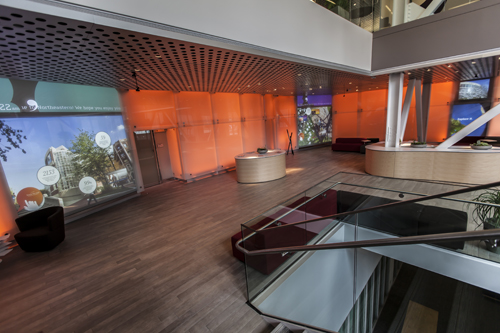- Carved from an existing building at the heart of campus, the new Visitor Center at Boston’s Northeastern University acts as a shop-window for the academic facility’s combination of assets, talents and opportunities. Featuring three different large-scale interactive display areas, the Visitor Center’s lobby also showcases the high-quality optics, flexible specification, and consistent color rendering of DLP projectors and ProNet.precision software from Norway’s projectiondesign.
The Boston architecture firm of William Rawn Associates was commissioned by the University to design the Visitor Center, with Cavanaugh Tocci Associates acting as consultants for the AV system design throughout, and Downstream Technologies designing AV content and interactivity.
“The client brief was to create a ‘high-tech, high-touch’ space that would engage the 70,000 visitors who come to get a flavor of Northeastern every year,” said Matthew J. Moore of Cavanaugh Tocci Associates. “The Visitor Center is run by the admissions office and their audience is high-school and other prospective students and their families. The Center is open from 8am to 6pm every day, so it’s a busy place.”
Between them, the architects, consultants, content people and systems integration firm the Whitlock Group evolved the idea of creating two large interactive video screens in the Visitor Center’s lobby, along with a ‘Spinning Globe’ that would underline the University’s commitment to international study.
But while one part of the brief appeared to provide a free rein for the Center’s systems design, another part of it imposed significant constraints. “The University wanted to make the technology disappear when it was not in use,” said Moore. “They saw this as an evolving space, and they wanted the projection glass to blend seamlessly with the architectural glass of the lobby walls.”
With front-projection being ruled out as being too visible a technology for the space, the team went about designing a rear-projection solution. But here, too, there were issues. Space behind the walls was limited, giving RP Visuals, the company tasked with designing the mounts for the projectors, more than a few headaches.
“Each of the three ‘touch experience’ areas was unique and each one represented an optical challenge,” said Randy Pagnan, President of RP Visuals. “Most obviously, each design called for edge-blending of multiple projected images, and in no instance were we able to use multi-point mirrors, six-axis mounts, or the ideal lens optics for blending.
“Nonetheless, with projectiondesign’s lens options and WB2560 multi-image processor, together with ProNet.precision software and Stewart Filmscreen projection surfaces, we were able to engineer solutions that did not compromise the results in any way – despite almost all of our ‘golden rules for blending’ being broken.”
The end result sees four projectiondesign F32 SXGA+ DLP projectors in a 2 x 2 blended configuration driving one touchscreen measuring around 7.5ft high by 9.25ft wide, while a pair of F32 1080p projectors mounted side-by-side powers a 2.5ft by 9.25ft banner area above.
On the opposite wall is an almost identical configuration – the same height but slightly wider to fit with the space available between the architectural glass wall and the lobby entrance.
The ‘Spinning Globe’ screen sees two projectiondesign F32 SXGA+ resolution projectors throwing onto a surface 6.5ft high by 5ft wide, with a 4ft banner area above powered by a single F32 1080p.
PQ Labs Multi-Touch G32 overlays are used on the projection surfaces to bring motion data to a series of 12 network computers, allowing visitors to come up to each screen and interact with its content using all ten fingers. Visitors can pull up videos, still images and information, choosing data on particular education programs using a GUI developed by Downstream.
News feeds come from Twitter and RSS, while the static banners atop the two main walls display different content in keeping with the time of day and complementing the lobby’s LED lighting system.
“The architectural and technology designs were heavily influenced by the existing conditions, and depth for the rear-projection zone of the interactive displays was extremely tight, making the margin for error very small for the implementation of a blended projected image,” said CTA’s Moore.
“With great teamwork, careful component and software selection, a dedicated installation team from Whitlock and technical support from projectiondesign throughout the planning, design and project completion phases, we were able to achieve high-quality seamless images in a very constrained space.”
Cheryl Mason Cox, Marketing & Communications Director for the Whitlock Group, said, “We will provide ongoing managed services to the University and are confident that projectiondesign will support us in the post-installation phase as well.”










